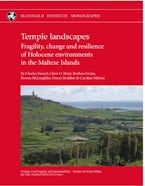Through a series of case studies, this third volume in the Earth series deals with the technological constraints and innovations that enabled societies to survive and thrive across a range of environmental conditions. The contributions are structured into three sections to draw out particular commonalities and contrasts in the choices made by pre-industrial communities in the construction of varied landscapes and cultural heritage:
Landnam, from the Old Norse for ‘taking of land’, deals with colonization, including the drivers and processes through which colonizers developed an understanding of the productive potential and limitations of their new lands.
Fields and field systems: Field-walls are a distinctive and apparently timeless characteristic of many pre-industrial farming landscapes but they present many the challenges to their study, such as the effects of plowing, abandonment and land-use change and of urban development in fertile lowland zones which may eradicate, reduce or conceal past systems of land-use and division. The importance of indirect and proxy evidence is illustrated and the value of interdisciplinary and modeling approaches emphasized.
Agro-pastoralism: focuses on the complex ‘time-space adaptations’ devised for managing cultivation and livestock production, particularly the need to prevent stock incursions into arable fields during the growing season whilst making effective use of seasonal grazing resources. The contributions focus on mountainous areas, where temporary migrations, in the form of transhumance, provided access to a diversity of resources based around seasonal constraints on their availability and productivity.
I. LANDNÁM
1.1 Introduction
1.2 Ancient desert farming in the Southern ‘Araba Valley, Israel
1.3 Neolithic agriculture in Mediterranean wetlands: a complement to pastoralism at Polje Čepić (Istria, Croatia)
1.4 The Northern frontier. Northern Atlantic farming
1.5 Becoming islanders. Migration and settlement in the Balearic Islands (10th-13th centuries)
1.6 The transformation of wet lands: the example of the alluvial valleys of Languedoc and Provence during the medieval period (10th-13th centuries)
1.7 The formation of new villages on the northeastern slopes of the Andes
II. FIELDS AND FIELD SYSTEMS
2.1 Introduction
2.2 Fields in prehistoric Bohemia –fact and fiction
2.3 Stability and changes in the agricultural use of limestone soils in northern Estonia
2.4 Prehistoric agriculture and the ancient fields of Mikkeli Orijärvi, Finland
2.5 Ridge and furrow fields - Field systems c. 1000-1800 as a stabilising factor in an agricultural society – a Danish example
2.6 Coping with gravity: the case of mas l’Agustí (Montseny Mountains, Catalonia, Spain, c.15th-18th centuries)
2.7 Landscape Change and Staircase Farming in the Andes of Peru
2.8 Managing slopes for agricultural purposes: terrace typology in Andalusi hydraulic systems (Spain)
2.9 From a pre-urban to an urban landscape. Evidence for the evolution of early medieval plough system. Brussels, Belgium
III. AGRO-PASTORALISM
3.1. Introduction
3.2 Pastoralism, landscapes and forest-use in the late Neolithic in southern Germany
3.3 Flexibility in upland farming: pollen evidence for the role of shielings in the Scottish farm economy from c.1600-1900
3.4 Moving up and down. Two cases of seasonal family dwellings in mountainous areas: Mid-Norway and the South-Western Alps
3.5 An example of vernacular agro-pastoral landscape perception: the Provençal transhumant shepherd











